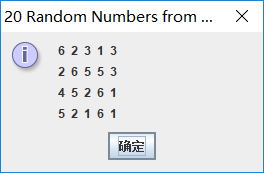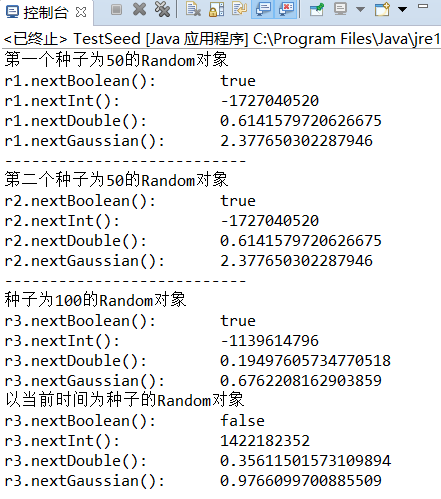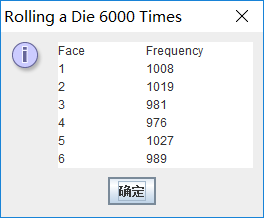1.JDK中的Math类
package ke1; public class TestMath { public static void main(String[] args) { /*---------下面是三角运算---------*/ //将弧度转换角度 System.out.println("Math.toDegrees(1.57):" + Math.toDegrees(1.57)); //将角度转换为弧度 System.out.println("Math.toRadians(90):" + Math.toRadians(90)); //计算反余弦,返回的角度范围在 0.0 到 pi 之间。 System.out.println("Math.acos(0.3):" + Math.acos(1.2)); //计算反正弦;返回的角度范围在 -pi/2 到 pi/2 之间。 System.out.println("Math.asin(0.8):" + Math.asin(0.8)); //计算反正切;返回的角度范围在 -pi/2 到 pi/2 之间。 System.out.println("Math.atan(2.3):" + Math.atan(2.3)); //计算三角余弦。 System.out.println("Math.cos(1.57):" + Math.cos(1.57)); //计算值的双曲余弦。 System.out.println("Math.cosh(1.2 ):" + Math.cosh(1.2 )); //计算正弦 System.out.println("Math.sin(1.57 ):" + Math.sin(1.57 )); //计算双曲正弦 System.out.println("Math.sinh(1.2 ):" + Math.sinh(1.2 )); //计算三角正切 System.out.println("Math.tan(0.8 ):" + Math.tan(0.8 )); //计算双曲余弦 System.out.println("Math.tanh(2.1 ):" + Math.tanh(2.1 )); //将矩形坐标 (x, y) 转换成极坐标 (r, thet));,返回所得角 theta。 System.out.println("Math.atan2(0.1, 0.2):" + Math.atan2(0.1, 0.2)); /*---------下面是取整运算---------*/ //取整,返回小于目标数的最大整数。 System.out.println("Math.floor(-1.2 ):" + Math.floor(-1.2 )); //取整,返回大于目标数的最小整数。 System.out.println("Math.ceil(1.2):" + Math.ceil(1.2)); //四舍五入取整 System.out.println("Math.round(2.3 ):" + Math.round(2.3 )); /*---------下面是乘方、开方、指数运算---------*/ //计算平方根。 System.out.println("Math.sqrt(2.3 ):" + Math.sqrt(2.3 )); //计算立方根。 System.out.println("Math.cbrt(9):" + Math.cbrt(9)); //返回欧拉数 e 的n次幂。 System.out.println("Math.exp(2):" + Math.exp(2)); //返回 sqrt(x2:" +y2),没有中间溢出或下溢。 System.out.println("Math.hypot(4 , 4):" + Math.hypot(4 , 4)); // 按照 IEEE 754 标准的规定,对两个参数进行余数运算。 System.out.println("Math.IEEEremainder(5 , 2):" + Math.IEEEremainder(5 , 2)); //计算乘方 System.out.println("Math.pow(3, 2):" + Math.pow(3, 2)); //计算自然对数 System.out.println("Math.log(12):" + Math.log(12)); //计算底数为 10 的对数。 System.out.println("Math.log10(9):" + Math.log10(9)); // 回参数与 1 之和的自然对数。 System.out.println("Math.log1p(9):" + Math.log1p(9)); /*---------下面是符号相关的运算---------*/ //计算绝对值。 System.out.println("Math.abs(-4.5):" + Math.abs(-4.5)); //符号赋值,返回带有第二个浮点数符号的第一个浮点参数。 System.out.println("Math.copySign(1.2, -1.0):" + Math.copySign(1.2, -1.0)); //符号函数;如果参数为 0,则返回 0;如果参数大于 0,则返回 1.0;如果参数小于 0,则返回 -1.0。 System.out.println("Math.signum(2.3):" + Math.signum(2.3)); /*---------下面是大小相关的运算运算---------*/ //找出最大值 System.out.println("Math.max(2.3 , 4.5):" + Math.max(2.3 , 4.5)); //计算最小值 System.out.println("Math.min(1.2 , 3.4):" + Math.min(1.2 , 3.4)); //返回第一个参数和第二个参数之间与第一个参数相邻的浮点数。 System.out.println("Math.nextAfter(1.2, 1.0):" + Math.nextAfter(1.2, 1.0)); //返回比目标数略大的浮点数 System.out.println("Math.nextUp(1.2 ):" + Math.nextUp(1.2 )); //返回一个伪随机数,该值大于等于 0.0 且小于 1.0。 System.out.println("Math.random():" + Math.random()); } }
2.Math.random()生成随机数
// RandomInt.java // Shifted, scaled random integers import javax.swing.JOptionPane; public class RandomInt { public static void main( String args[] ) { int value; String output = ""; for ( int i = 1; i <= 20; i++ ) { value = 1 + (int) ( Math.random() * 6 ); output += value + " "; if ( i % 5 == 0 ) output += "\n"; } JOptionPane.showMessageDialog( null, output, "20 Random Numbers from 1 to 6", JOptionPane.INFORMATION_MESSAGE ); System.exit( 0 ); } }
3.JDK提供了一个Random类,可以更方便地生成随机数
package ke1; // RandomInt.java // Shifted, scaled random integers import javax.swing.JOptionPane; public class RandomInt { public static void main( String args[] ) { int value; String output = ""; for ( int i = 1; i <= 20; i++ ) { value = 1 + (int) ( Math.random() * 6 ); output += value + " "; if ( i % 5 == 0 ) output += "\n"; } JOptionPane.showMessageDialog( null, output, "20 Random Numbers from 1 to 6", JOptionPane.INFORMATION_MESSAGE ); System.exit( 0 ); } }

4.取种子产生随机数
相同“种子(seed)”的Random对象会生成相同的随机数。
package ke1; import java.util.Random; public class TestSeed { public static void main(String[] args) { Random r1 = new Random(50); System.out.println("第一个种子为50的Random对象"); System.out.println("r1.nextBoolean():\t" + r1.nextBoolean()); System.out.println("r1.nextInt():\t\t" + r1.nextInt()); System.out.println("r1.nextDouble():\t" + r1.nextDouble()); System.out.println("r1.nextGaussian():\t" + r1.nextGaussian()); System.out.println("---------------------------"); Random r2 = new Random(50); System.out.println("第二个种子为50的Random对象"); System.out.println("r2.nextBoolean():\t" + r2.nextBoolean()); System.out.println("r2.nextInt():\t\t" + r2.nextInt()); System.out.println("r2.nextDouble():\t" + r2.nextDouble()); System.out.println("r2.nextGaussian():\t" + r2.nextGaussian()); System.out.println("---------------------------"); Random r3 = new Random(100); System.out.println("种子为100的Random对象"); System.out.println("r3.nextBoolean():\t" + r3.nextBoolean()); System.out.println("r3.nextInt():\t\t" + r3.nextInt()); System.out.println("r3.nextDouble():\t" + r3.nextDouble()); System.out.println("r3.nextGaussian():\t" + r3.nextGaussian()); Random r4 = new Random(System.currentTimeMillis()); System.out.println("以当前时间为种子的Random对象"); System.out.println("r3.nextBoolean():\t" + r4.nextBoolean()); System.out.println("r3.nextInt():\t\t" + r4.nextInt()); System.out.println("r3.nextDouble():\t" + r4.nextDouble()); System.out.println("r3.nextGaussian():\t" + r4.nextGaussian()); } }

5.利用随机数来模拟骰子滚动的统计结果
// RollDie.java // Roll a six-sided die 6000 times import javax.swing.*; public class RollDie { public static void main( String args[] ) { int frequency1 = 0, frequency2 = 0, frequency3 = 0, frequency4 = 0, frequency5 = 0, frequency6 = 0, face; // summarize results for ( int roll = 1; roll <= 6000; roll++ ) { face = 1 + (int) ( Math.random() * 6 ); switch ( face ) { case 1: ++frequency1; break; case 2: ++frequency2; break; case 3: ++frequency3; break; case 4: ++frequency4; break; case 5: ++frequency5; break; case 6: ++frequency6; break; } } JTextArea outputArea = new JTextArea( 7, 10 ); outputArea.setText( "Face\tFrequency" + "\n1\t" + frequency1 + "\n2\t" + frequency2 + "\n3\t" + frequency3 + "\n4\t" + frequency4 + "\n5\t" + frequency5 + "\n6\t" + frequency6 ); JOptionPane.showMessageDialog( null, outputArea, "Rolling a Die 6000 Times", JOptionPane.INFORMATION_MESSAGE ); System.exit( 0 ); } }

6. JDK5.0起,Java支持可变参数的方法
package ke1; import java.awt.*; import java.awt.event.*; import java.util.*; public class VariableArgumentsTest{ public static double max(double...values) { double largest=Double.MIN_VALUE; for (double v:values) if(v>largest) largest=v; return largest; } public static void main(String args[]) { System.out.println("Max:"+max(1,11,300,2,3)); } }

7.重载
package ke1; // MethodOverload.java // Using overloaded methods public class MethodOverload { public static void main(String[] args) { System.out.println("The square of integer 7 is " + square(7)); System.out.println("\nThe square of double 7.5 is " + square(7.5)); } public static int square(int x) { return x * x; } public static double square(double y) { return y * y; } }

8.阶乘递归
package ke1; import java.math.BigInteger; import java.util.Scanner; public class CalculateN { /** * @param args */ public static void main(String[] args) { System.out.print("请输入N:"); Scanner scanner=new Scanner(System.in); int number=scanner.nextInt(); System.out.println(number+"!="+calculateN2(number)); } public static long calculateN(int n) { if(n==1 || n==0){ return 1; } return n*calculateN(n-1); } public static BigInteger calculateN2(int n) { if(n==1 || n==0){ return BigInteger.valueOf(1); } return BigInteger.valueOf(n).multiply(calculateN2((n-1))); } }

9.求平方数的静方法Square。
package ke1; public class SquareInt { public static void main(String[] args) { int result; for (int x = 1; x <= 10; x++) { result = square(x); // Math库中也提供了求平方数的方法 // result=(int)Math.pow(x,2); System.out.println("The square of " + x + " is " + result + "\n"); } } // 自定义求平方数的静态方法 public static int square(int y) { return y * y; } }
